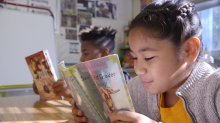Why Diverse Classroom Libraries Matter
At a school in Oakland, California, students see themselves—and the broader world—in the books they read.
Your content has been saved!
Go to My Saved Content.Second- and third-grade students at Reach Academy in Oakland, California, are huddled quietly together on a rug to hear their teacher, Natalya Gibbs, read Princess Grace. There are no tussles, no chatter, no snickering, as Gibbs pans the book in a half circle so that each student can see the illustrations.
The pink and purple book cover depicting a girl in a tiara and puffy dress turns out to be misleading: this isn’t your typical fairy tale. Grace, the central character, wistfully hopes she’s chosen to be a princess in her town’s annual parade, but with the help of her friends and her nana, she realizes that not all princesses have to wear a crown and frilly dress or “have a daddy of [their] own.” After hearing the stories of princesses from all over the world—warriors, artists, and scientists—Grace decides she wants to be a Gambian princess and goes to the parade sporting traditional kente robes.
“Why do you think Grace changed her mind about the kind of princess she wanted to be?” Gibbs pauses reading to ask the class. “The other princesses seem like more fun and she didn’t want to just stand around looking pretty,” responds one student.
During her own childhood, Gibbs remembers escaping through books, happy to read most anything she could get her hands on. But as she got older, it got harder to find books that resonated with her. “I wanted to see myself reflected in stories because I started to become more aware of my own identity—I am mixed [race] and where do I fit in?” she says.
These memories of reading—and looking for good books to read—have inspired Gibbs’s teaching practices over her three years at Reach Academy, a Title I elementary school of 400 students. In her class of 22, Gibbs tries to ensure that her classroom library provides a mirror for her students—a world in which they can see characters and themes that reflect their identities and experiences, such as skin color or hair style, family and home life structures, spoken languages, or abilities.
But mirrors aren’t enough, Gibbs adds. At Reach Academy, nearly all students are students of color. Once students “feel seen themselves,” it’s also critical that they be exposed to characters and stories that are different—windows into the lives, customs, and beliefs of others “so that when they grow up, they are able to work with all different kinds of people.”
Too often, children from marginalized populations, like those at Reach Academy, have felt neglected in popular literature, wrote Rudine Sims Bishop, a writer and professor emeritus at Ohio State University, whose 1990 essay “Mirrors, Windows, and Sliding Glass Doors” is credited with the windows and mirrors framing. Bishop held that “when children cannot find themselves reflected in the books they read…they learn a powerful lesson about how they are devalued in the society of which they are a part.”
But she also emphasized that diverse literature is equally valuable in more homogeneous schools where certain demographic groups dominate: “Books may be one of the few places where children who are socially isolated and insulated from the larger world may meet people unlike themselves,” said Bishop.
In the decades since Bishop’s essay was published, “windows and mirrors” has been widely adopted as a pedagogical approach in classrooms. The Teaching Tolerance website, for example, features a lesson plan for teachers that helps students identify windows and mirrors in their own reading. And We Need Diverse Books, a nonprofit that partners with Scholastic, offers recommendations and support for educators hoping to diversify their class reading lists.
The concept has been applied in other subjects besides English language arts: social studies teachers are increasingly including the stories of historical figures often left out of textbooks, and STEM teachers are making more of an effort to depict scientists and mathematicians who are women or people of color in hopes of addressing larger disparities in the field.
Though budgets are tight for most schools, even small changes—like sharing one book that references a child’s experiences—can have an impact on student engagement, says Gibbs. She emphasizes that materials also matter, and makes a point of including posters, wall hangings, and even skin-toned crayons so that children “can see themselves in all aspects of their classroom.”
“It’s about ‘Who is this class? What do they bring?’ I’m growing my curriculum based on the community of children that I have each year, which means learning about my students and their cultures and making sure that they’re represented,” says Gibbs.
